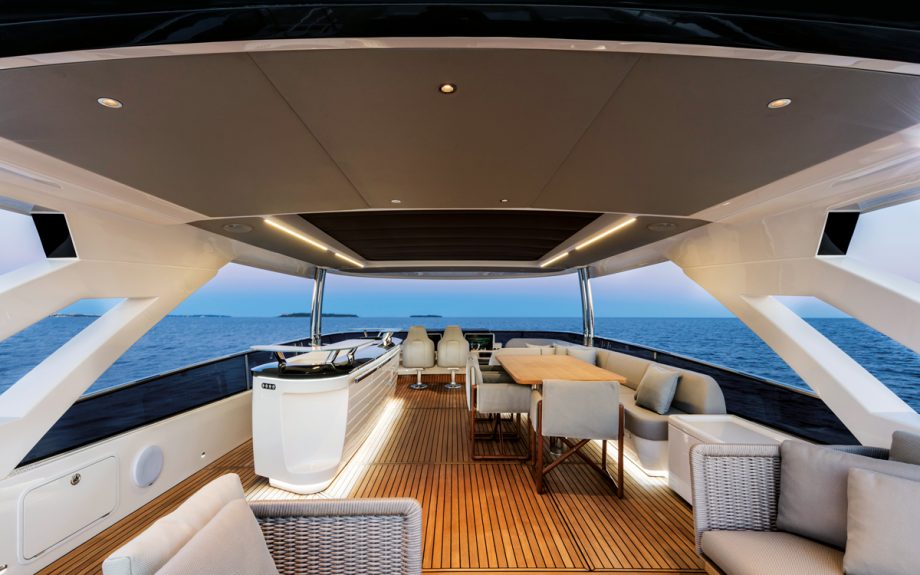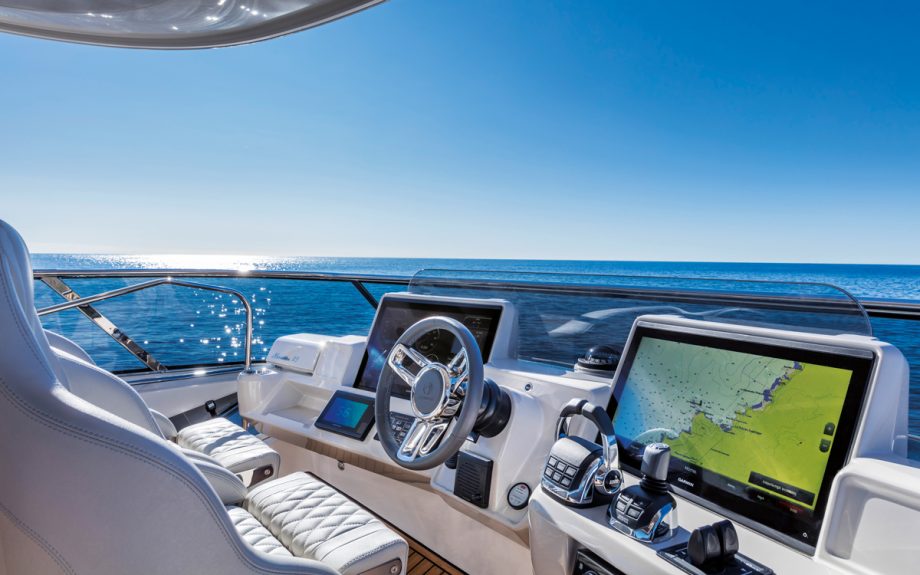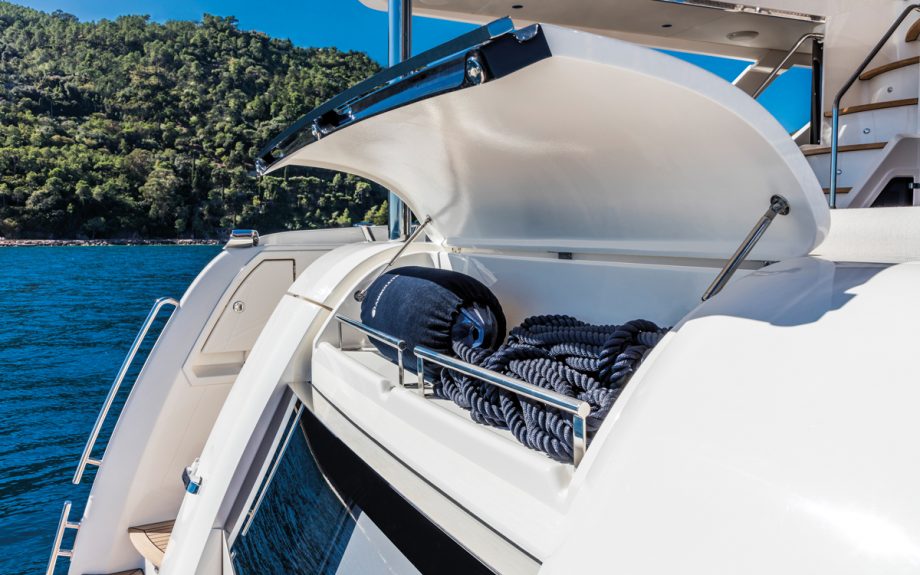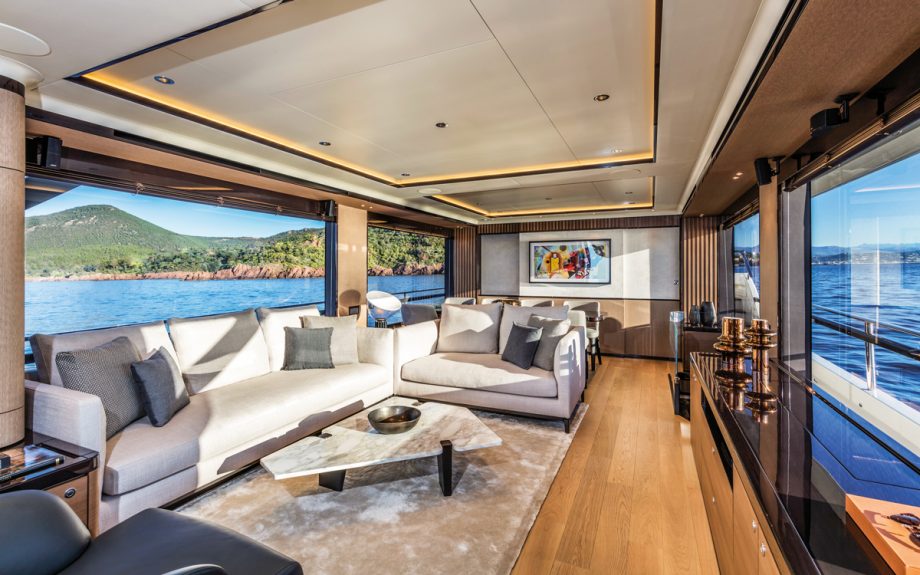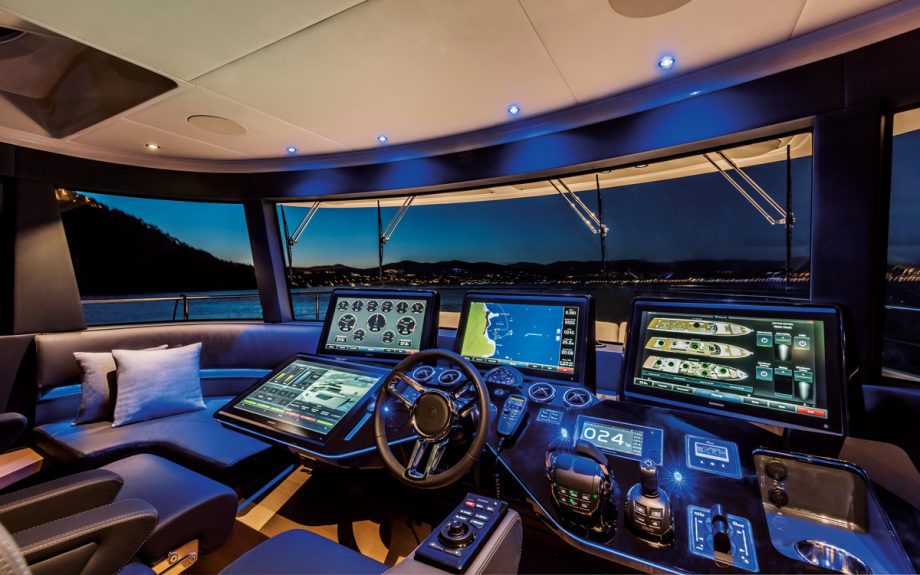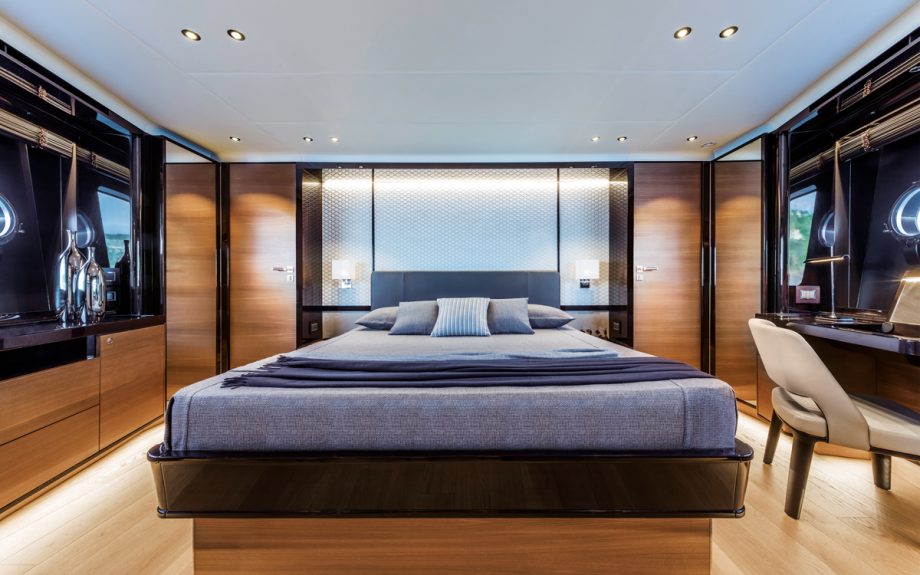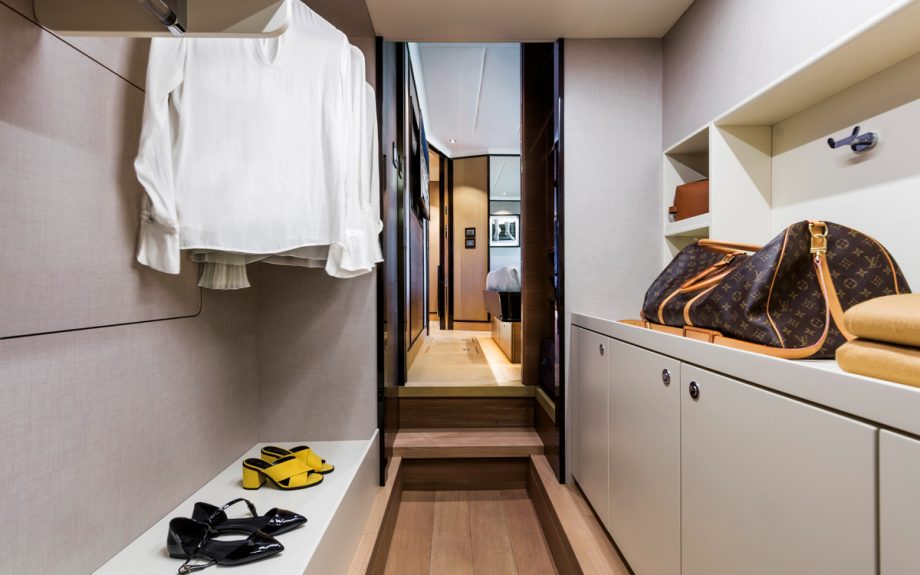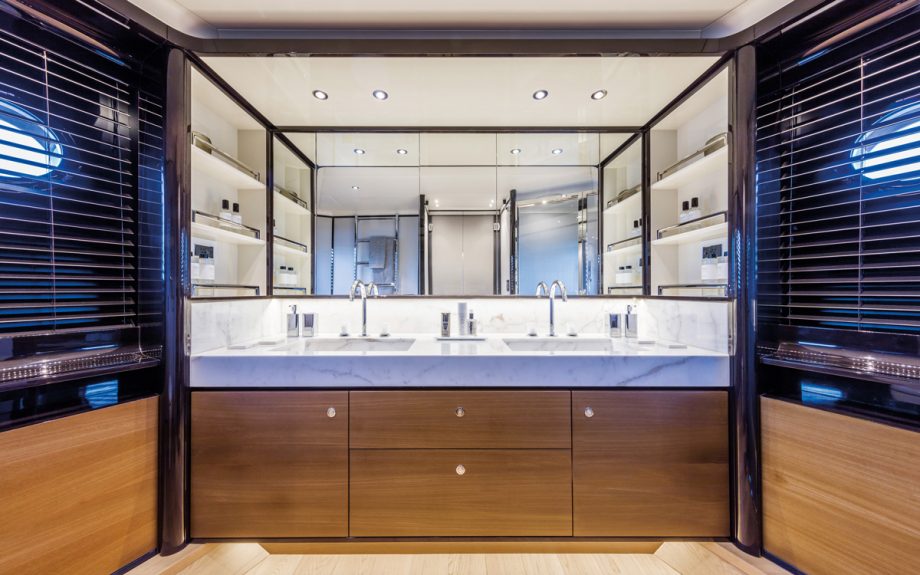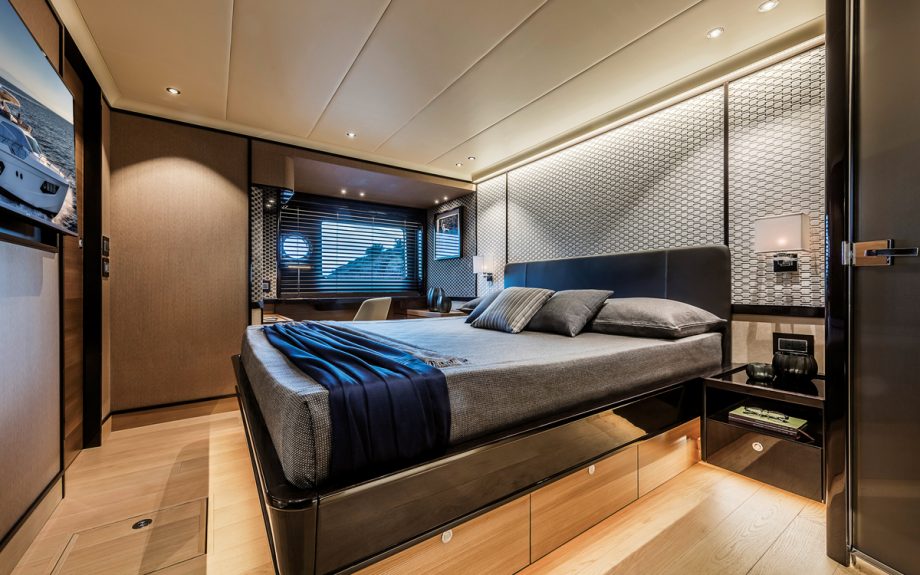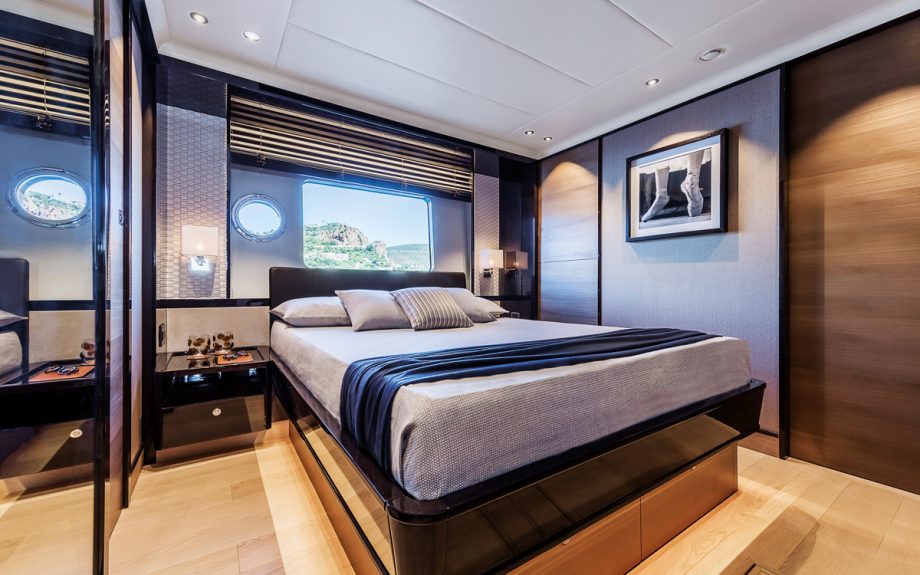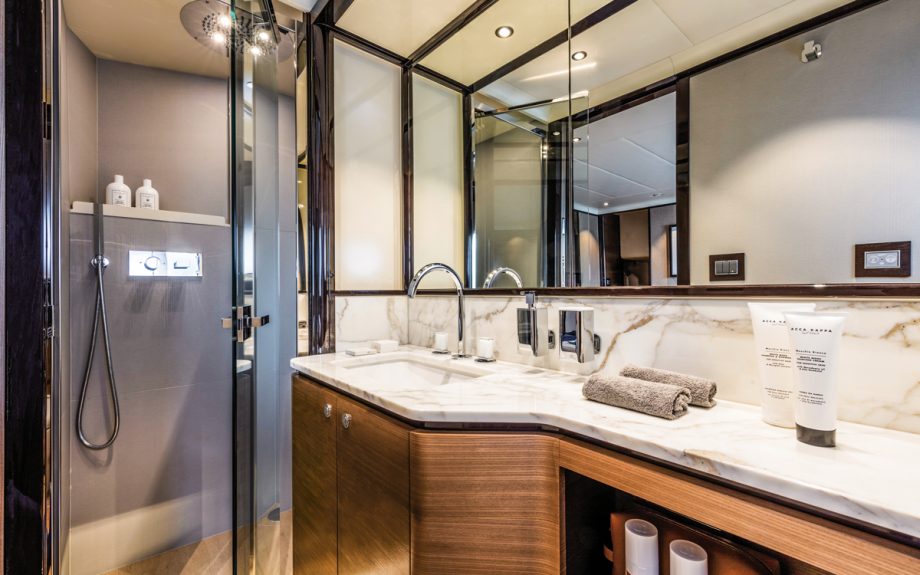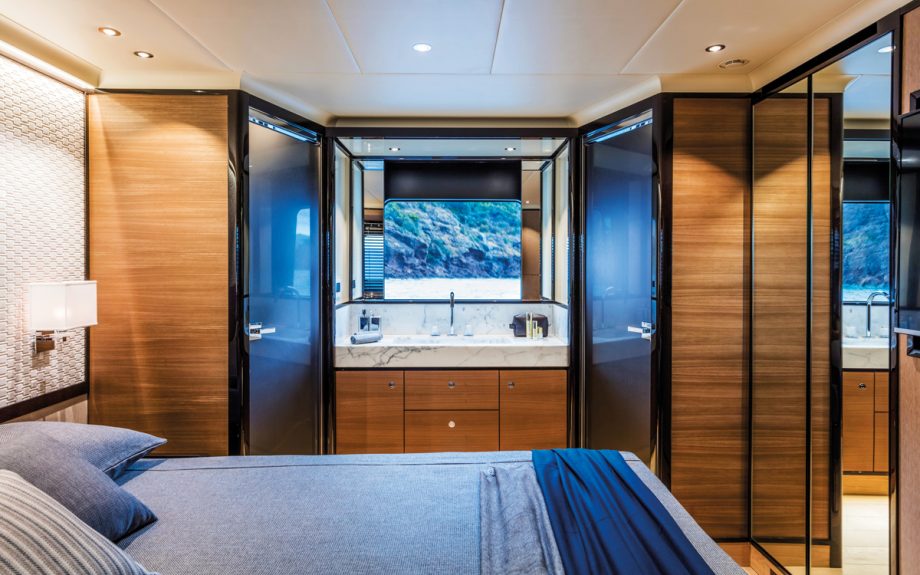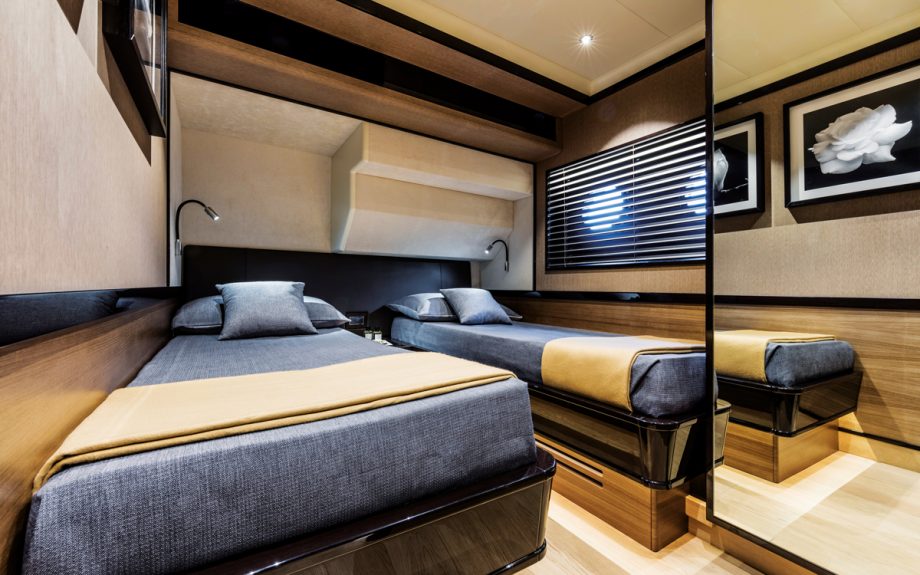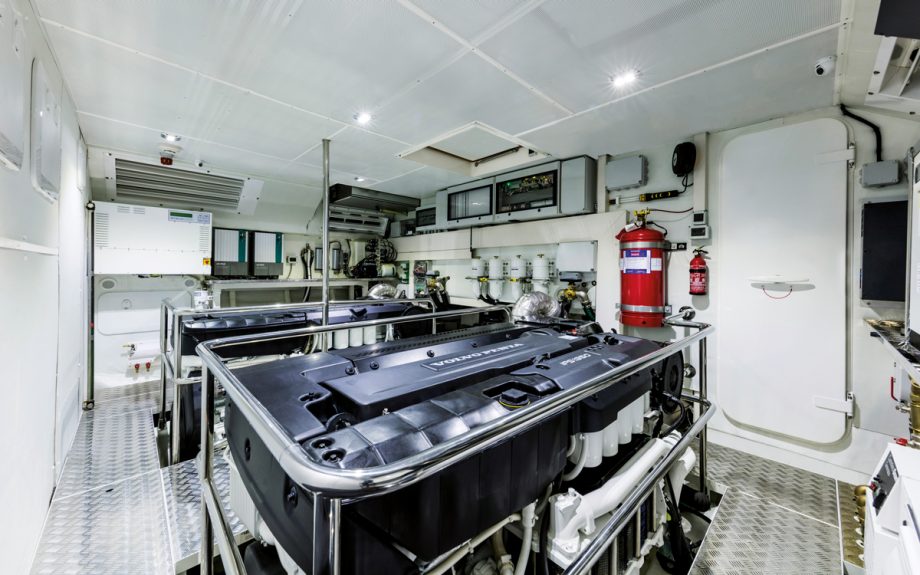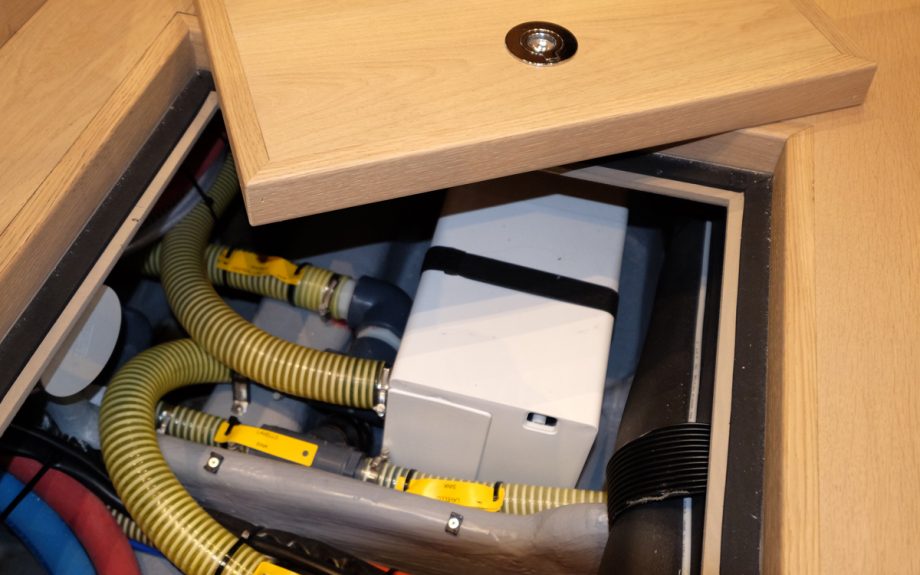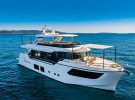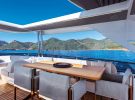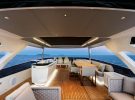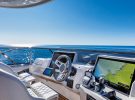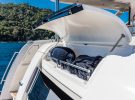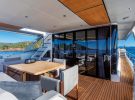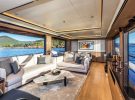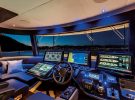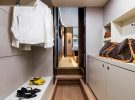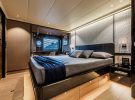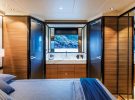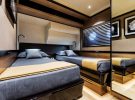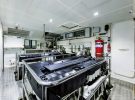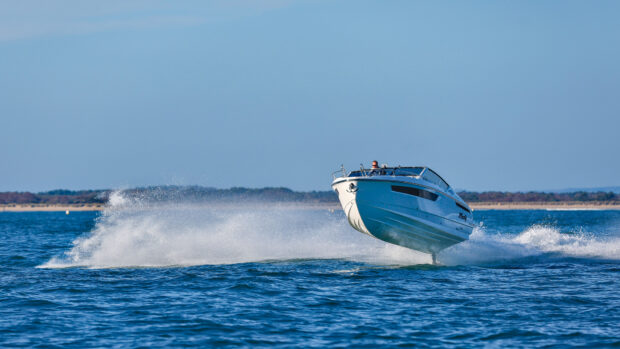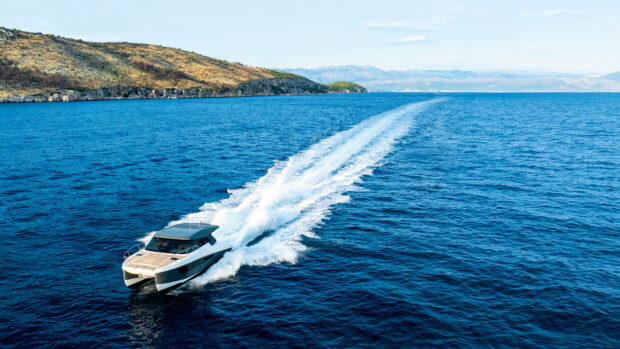The bravest design yet from the Italian yard, the Absolute Navetta 73 has paid dividends in terms of space, light and fuel efficiency
From down on the pontoon, it seems huge, inelegant and angular. Moored stern to the quay, it appears roomy and inviting. Seen out on the water, it looks purposeful and businesslike. There is no angle from which the new Absolute Navetta 73 can be described as pretty, but I doubt the yard’s design department is losing much sleep over that.
Absolute has always enjoyed ploughing its own individual furrow and in the 15 years of its existence, it has created a unique persona for itself as a company whose boats are often unusual and sometimes brilliant, but never boring.
The Absolute Navetta 73 is not an especially beamy boat for its length, but with its massive square stern, it looks like it is. That impression is heightened by a huge full-beam flybridge, which completely shades the cockpit and, for most of their length, the side decks too.
It was unveiled at the Cannes Yachting Festival in September 2017 and sat among the gleaming, sleek and delicate-looking boats like a bouncer surrounded by bridesmaids. Any larger-than-life exterior is, naturally, built around an equally voluminous interior.
The Absolute Navetta 73’s hull carries its beam well forward, at both gunwale and waterline, and with the engineroom bulkhead situated some way aft of midships, there is plenty of room for accommodation.
The layout is unusual. The master cabin sits forward on its own level, down six steps from the main deck but significantly higher than the lower deck – a decision forced on the designers by the limited space available down in that narrow bow.
So it has flat floors, a spacious head and shower compartment behind glass double doors in the bows, and gigantic rectangular windows. A properly usable walk-in wardrobe and plenty of ancillary lockers and drawers provide plenty of stowage for clothes, albeit with a lack of full-length hanging space.
The bed is enormous and in common with all the guest cabins, headroom is a generous 6ft 6in (1.98m). It seemed perverse not to fit under-berth drawers as well – why ever not? – but the reason for that became plain soon enough.
Article continues below…

Azimut Magellano 76
A video report of the Azimut Magellano 76 from the Genoa Boar Show 2012

Absolute Navetta 68: Italian trawler range to grow again with Cannes debut
Down on the lower deck, which is reached via the companionway on the starboard side of the saloon, the midships VIP cabin can’t quite compete with the owner’s, but it nevertheless shares a luxurious sense of space.
Placing the sink under the port-side window and putting the shower and heads in separate compartments either side of it, clearly places a higher premium on light and space below decks than on keeping the plumbing hidden from view, which evinces a proper sense of priorities.
Space to spare
At first, the port VIP cabin hardly seems to merit such a title, but slide open that forward door and it turns out to have a vast dressing room, down two steps. Although it’s tucked into the void space beneath the master cabin’s double berth (aha!), it still has more than 6ft (1.85m) of headroom.
This area obviously doesn’t show up on the layout diagram but I can assure you it’s real, and with shelving, lockers and hanging space, it has much to recommend it.
The fourth cabin is a twin berth on the starboard side with just a hanging locker in which to stow your stuff, but the beds are a full 6ft 6in (1.98m) long. If you asked nicely, the shipyard might fit a door to provide it with ensuite access to the day head at the bottom of the companionway.
That vertical windscreen isn’t just purposeful-looking and easy to see through – it also allows the wheelhouse to be set pretty far forward, without encroaching on the foredeck. This, of course, leaves plenty of space on the rest of the main deck, while big side windows ensure the saloon feels as spacious as it looks, even while sacrificing width to the Absolute Navetta 73’s excellent side decks. These are 18in (46cm) wide and secure behind a guardrail height of 32in (81cm).
Set between saloon and wheelhouse, the galley has its own access to the side deck and wheelhouse, while the sliding door to starboard means that crew and guest areas can be separated if necessary.
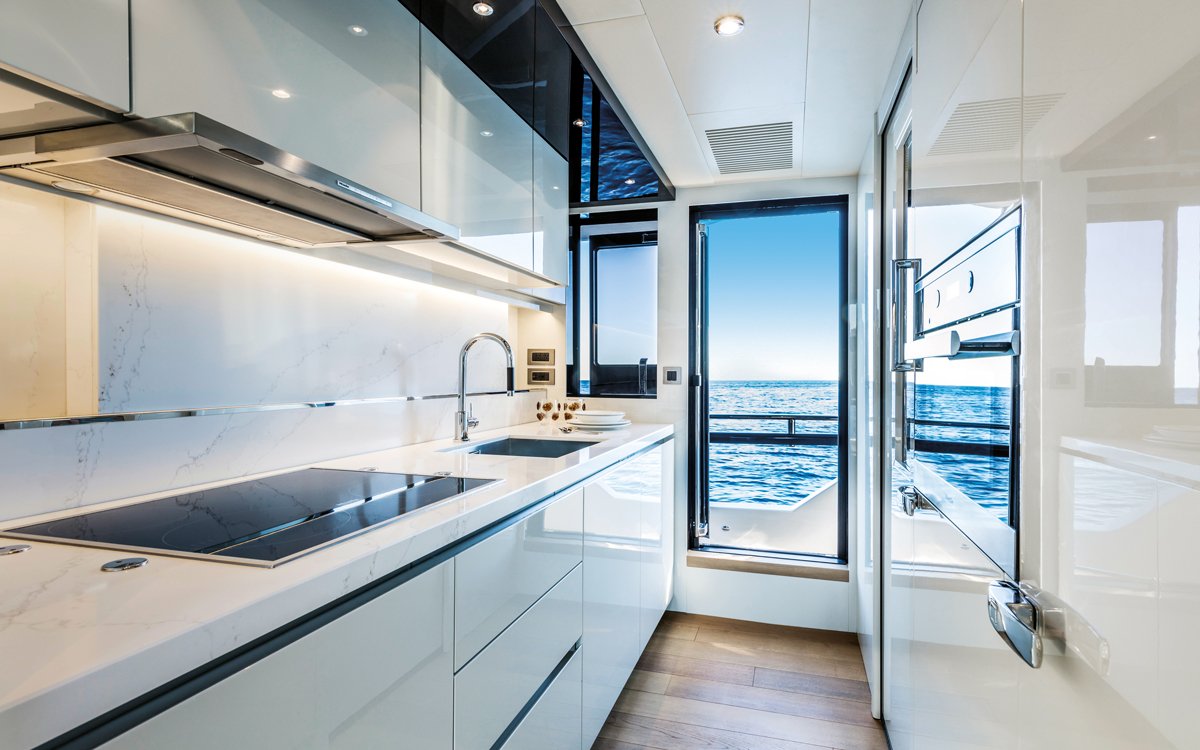
The main deck galley has access from the side decks as well as the saloon so that when professional crew are employed, they can come and go without disturbing guests
It is rather long and thin, but well endowed with refrigeration, freezer and stowage space. Drawers and lockers for crockery and glassware can be found in the lobby outside. The wheelhouse has its own flybridge companionway for rapid access to the upper helm, and is also reasonably well placed to use the galley’s door out to the side deck.
If you do cruise with crew, you shouldn’t have too many complaints about the cabin in the stern. On our test boat, it was equipped with a single berth – more can be fitted on request – a separate head and shower compartment, a convertible dinette, a washer-dryer, some useful lockers and extra fridge and freezer space. Headroom comes in at 6ft 7in (2.01m).
Various choices of interior finish are available. The boat exhibited at Cannes had Minotti furniture inside and Paola Lenti chairs up on the flybridge, with dark gloss walnut and elm veneers used throughout the interior, floors of oak, fabric-clad bulkheads and leather and lacquer trim.
Fitted as standard, the Absolute Navetta 73’s magnetic surfaces are a fun party piece: both the dining table and the flybridge table are constructed with a thin steel sheet beneath the veneer so that the yacht’s compatible wine glasses – each with a small magnet set into the base – don’t fall over and smash.
Like all of its Absolute stablemates since 2008, the Navetta is designed solely around Volvo’s IPS system. It might seem a surprisingly big and weighty craft for pod drives and indeed, its only engine option is the largest available, the 1,000hp IPS1350, which compares with the 1,400hp or 1,550hp units that you might expect to find on more conventional shaftdrive yachts of this size.
Performance
With its plumb bow and very fine entry, the Absolute Navetta 73’s hull shape has a faintly Edwardian look about it, although the naval architects of 100 years ago would never have tried to match the Navetta’s ample bulk with any ideas of high performance – which, by the standards of those times, the Navetta possesses in abundance.
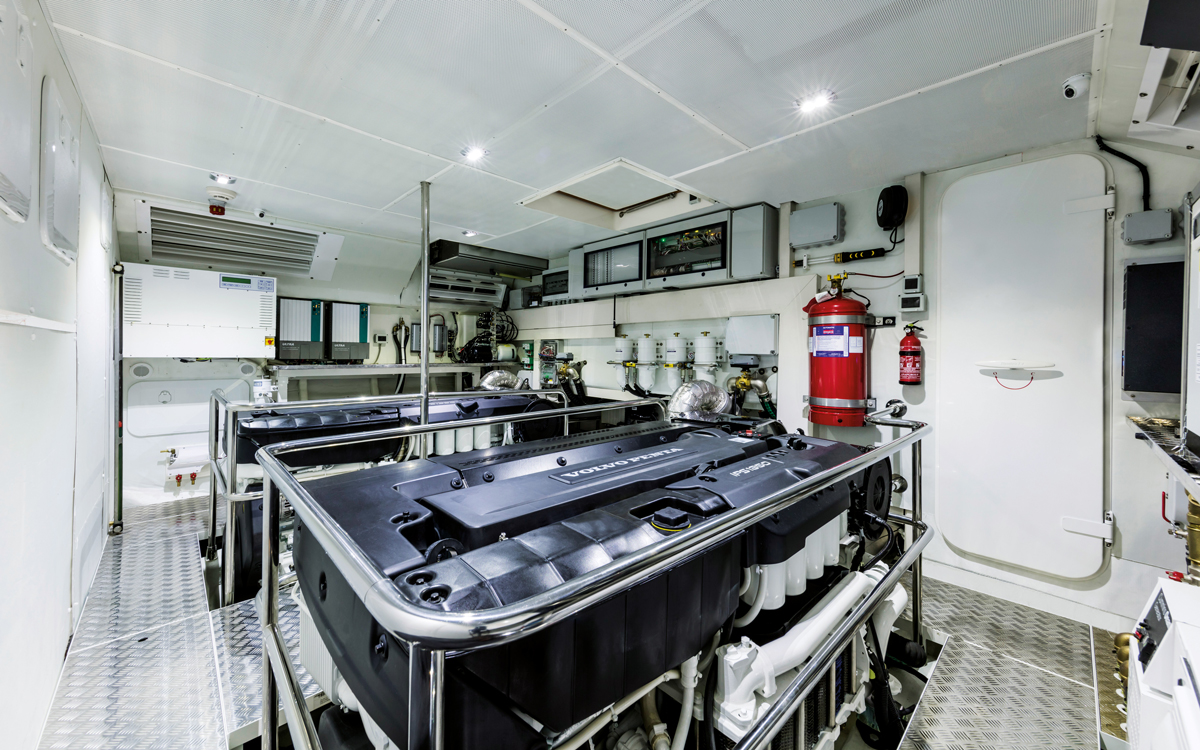
With easy access, flat-mounted engines, 6ft 2in (1.88m) of headroom over the treadplate walkways and plenty of space to get at everything except the IPS drives which are rather buried down the back, the engineroom is a terrific space
As an understanding of planing hull characteristics began to mature in design circles during the 1930s and ’40s, it was realised that simply marrying a knife-like bow with load- bearing midships and aft sections was not the ideal compromise.
If the deadrise angle changed too abruptly, the resultant impact zone could pound both the boat and its crew to pieces, as many a young seaman in the torpedo boats of the time could testify.
Of course, the Absolute Navetta 73 is not designed to achieve the 40 knots or more of the plywood navy, but to ensure a soft ride in a head sea, its deadrise still decreases at a fairly restrained rate, as seen in the line of the chine, which starts high and proud on the stem and meets the waterline around a third of the way back to the transom as the bottom flattens out, quite gradually, to a shallow 7.4° right aft.
Another potential side effect of a superfine entry is the deluge of spray, which it throws up at speed, and to counter this, the Absolute Navetta 73 has a broad flat at the chine that continues right around the stem, helping keep the sea where it belongs.
As so often seems to be the case whenever there is an intriguing and unusual hull to test, conditions on the day were about as challenging as the Round Pond in Kensington Gardens. A light breeze could lift no more than a modest chop on the waters of the Baie de Cannes. It would have been fun in a RIB, but the Absolute Navetta 73 simply didn’t notice.
Acceleration was steady and linear with no discernible ‘hump’ as the broad, flat lifting surfaces did their thing. The boat simply climbed out of the hole and kept going, longitudinal trim increasing gradually once hull speed was exceeded and reaching 5° at our maximum of 25.6 knots.
Acceleration had a surprising urge to it. A low planing speed can be useful in a cruising yacht, as it allows you to make progress even if conditions have forced you to ease back on the throttles. The Absolute Navetta 73’s flat aft sections kept it securely on the plane at just 14 knots – although the massive wake spreading out astern was a quick antidote to any delusions of hydrodynamic efficiency.
Of course, our wake came in useful for trying out that fine entry, which sliced through it like butter with little vertical acceleration and no discernible check on our progress. It felt quite impressive. We kept the Seakeeper gyro stabiliser switched off and the trim tabs fully up, and the Absolute Navetta 73 handled quite conventionally, turning with a slight inward heel and proving more nimble and enjoyable to drive than it looks.
Verdict
At first glance, it’s clear the Absolute Navetta 73 is offering something out of the ordinary. You don’t build a boat with such attention-grabbing looks if you want it to blend in. And the shipyard is right to demand your attention, because this is an innovative craft which is worth seeking out for lots of reasons, especially the way in which the forward accommodation spaces are handled. The master cabin being on its own deck level creates lots of usable space below without the need for a separate, raised wheelhouse. Necessity is the mother of invention: the bow’s shape forced the designers to raise the level of the forward suite, and their solution works brilliantly. The Navetta also has an effective hull design, which is notable not just for the way its razor-sharp bow slices through a chop, but because its acreage of flat lifting surfaces helps make it more fuel efficient than most of its counterparts. The low drag IPS pods also play a part. Packing less power, the Absolute Navetta 73 might not have the top speed of a Princess 75 but from tickover to 25 knots or so, it is burning much less fuel. That just leaves its looks. But beauty isn’t always an absolute. As Ayckbourn put it in The Norman Conquests, “Anybody I love is automatically beautiful.”
Details
Price from: £2.46 million (ex VAT)
Price as tested: £3.79 million (inc VAT)
LOA: 72ft 8in (22.19m)
Beam: 18ft 4in (5.60m)
Draught: 5ft 4in (1.62m)
Displacement: 57.7 tonnes (light)
Fuel capacity: 880 imp gal (4,000 litres)
Water capacity: 244 imp gal (1,110 litres)
Test engines: Twin 1,000hp Volvo Penta IPS 1350
Top speed on test: 25.6 knots
Cruising range at 9 knots: 728 miles
RCD Category: B for 18 people
Design: Absolute






